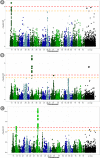Optimizing Training Population Size and Genotyping Strategy for Genomic Prediction Using Association Study Results and Pedigree Information. A Case of Study in Advanced Wheat Breeding Lines
- PMID: 28081208
- PMCID: PMC5231327
- DOI: 10.1371/journal.pone.0169606
Optimizing Training Population Size and Genotyping Strategy for Genomic Prediction Using Association Study Results and Pedigree Information. A Case of Study in Advanced Wheat Breeding Lines
Abstract
Wheat breeding programs generate a large amount of variation which cannot be completely explored because of limited phenotyping throughput. Genomic prediction (GP) has been proposed as a new tool which provides breeding values estimations without the need of phenotyping all the material produced but only a subset of it named training population (TP). However, genotyping of all the accessions under analysis is needed and, therefore, optimizing TP dimension and genotyping strategy is pivotal to implement GP in commercial breeding schemes. Here, we explored the optimum TP size and we integrated pedigree records and genome wide association studies (GWAS) results to optimize the genotyping strategy. A total of 988 advanced wheat breeding lines were genotyped with the Illumina 15K SNPs wheat chip and phenotyped across several years and locations for yield, lodging, and starch content. Cross-validation using the largest possible TP size and all the SNPs available after editing (~11k), yielded predictive abilities (rGP) ranging between 0.5-0.6. In order to explore the Training population size, rGP were computed using progressively smaller TP. These exercises showed that TP of around 700 lines were enough to yield the highest observed rGP. Moreover, rGP were calculated by randomly reducing the SNPs number. This showed that around 1K markers were enough to reach the highest observed rGP. GWAS was used to identify markers associated with the traits analyzed. A GWAS-based selection of SNPs resulted in increased rGP when compared with random selection and few hundreds SNPs were sufficient to obtain the highest observed rGP. For each of these scenarios, advantages of adding the pedigree information were shown. Our results indicate that moderate TP sizes were enough to yield high rGP and that pedigree information and GWAS results can be used to greatly optimize the genotyping strategy.
Conflict of interest statement
The authors have declared that no competing interests exist. This research was partly funded by the commercial partner Nordic seed A/S. This does not alter our adherence to PLOS ONE policies on sharing data and materials.
Figures





Similar articles
-
Genomic Prediction and Genome-Wide Association Studies of Flour Yield and Alveograph Quality Traits Using Advanced Winter Wheat Breeding Material.Genes (Basel). 2019 Aug 31;10(9):669. doi: 10.3390/genes10090669. Genes (Basel). 2019. PMID: 31480460 Free PMC article.
-
A comparison between genotyping-by-sequencing and array-based scoring of SNPs for genomic prediction accuracy in winter wheat.Plant Sci. 2018 May;270:123-130. doi: 10.1016/j.plantsci.2018.02.019. Epub 2018 Feb 21. Plant Sci. 2018. PMID: 29576064
-
Genomic prediction and GWAS of yield, quality and disease-related traits in spring barley and winter wheat.Sci Rep. 2020 Feb 25;10(1):3347. doi: 10.1038/s41598-020-60203-2. Sci Rep. 2020. PMID: 32099054 Free PMC article.
-
From markers to genome-based breeding in wheat.Theor Appl Genet. 2019 Mar;132(3):767-784. doi: 10.1007/s00122-019-03286-4. Epub 2019 Jan 23. Theor Appl Genet. 2019. PMID: 30673804 Review.
-
Genome-wide association study as a powerful tool for dissecting competitive traits in legumes.Front Plant Sci. 2023 Aug 14;14:1123631. doi: 10.3389/fpls.2023.1123631. eCollection 2023. Front Plant Sci. 2023. PMID: 37645459 Free PMC article. Review.
Cited by
-
Genomic Selection in Winter Wheat Breeding Using a Recommender Approach.Genes (Basel). 2020 Jul 11;11(7):779. doi: 10.3390/genes11070779. Genes (Basel). 2020. PMID: 32664601 Free PMC article.
-
Use of multiple traits genomic prediction, genotype by environment interactions and spatial effect to improve prediction accuracy in yield data.PLoS One. 2020 May 13;15(5):e0232665. doi: 10.1371/journal.pone.0232665. eCollection 2020. PLoS One. 2020. PMID: 32401769 Free PMC article.
-
Genetic Dissection of Grain Yield of Maize and Yield-Related Traits Through Association Mapping and Genomic Prediction.Front Plant Sci. 2021 Jul 15;12:690059. doi: 10.3389/fpls.2021.690059. eCollection 2021. Front Plant Sci. 2021. PMID: 34335658 Free PMC article.
-
1k-RiCA (1K-Rice Custom Amplicon) a novel genotyping amplicon-based SNP assay for genetics and breeding applications in rice.Rice (N Y). 2019 Jul 26;12(1):55. doi: 10.1186/s12284-019-0311-0. Rice (N Y). 2019. PMID: 31350673 Free PMC article.
-
Genetic dissection of root architectural plasticity and identification of candidate loci in response to drought stress in bread wheat.BMC Genom Data. 2023 Jul 26;24(1):38. doi: 10.1186/s12863-023-01140-7. BMC Genom Data. 2023. PMID: 37495985 Free PMC article.
References
-
- Bernardo R. Quantitative traits in plants [Internet]. II edition Stemma press; 2010. Available: http://stemmapress.com
-
- Xu Y, Crouch JH. Marker-assisted selection in plant breeding: From publications to practice. Crop Sci. 2008;48: 391–407.
-
- Bernardo R. Molecular markers and selection for complex traits in plants: Learning from the last 20 years. Crop Sci. 2008;48: 1649–1664.
-
- Heffner EL, Sorrells ME, Jannink J-L. Genomic Selection for Crop Improvement. Crop Sci. 2009;49: 1.
MeSH terms
LinkOut - more resources
Full Text Sources
Other Literature Sources

